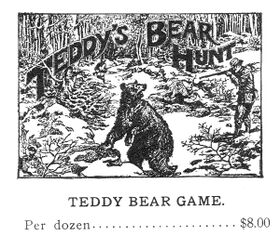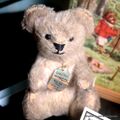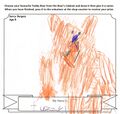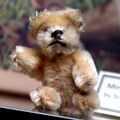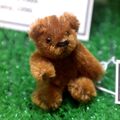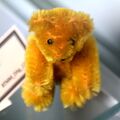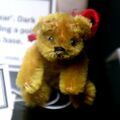Category:Teddybears
Some of the bears and teddybears in the Museum. This list is currently woefully incomplete.
Evolution of the Teddybear
~1880: A "savage" mechanical bear, Britains catalogue [image info]
1892: Fierce mechanical bear toy [image info]
1907:Teddy's Bear Hunt game [image info]
1907 advert, with an image that may or may not be one of the early Steiff bears [image info]
1907 Teddy Bear game. Note that the "cute" baby bear still has fangs [image info]
Pre-C20th
Up until the end of the Nineteenth Century, bears were typically regarded as fierce and dangerous creatures that were to be feared or hunted, much like tigers or wolves. Some travelling troupes and circuses had captive chained bears, but these were considered a novelty, and the welfare of the bears doesn't seem to have been much of an issue.
Theodore (Teddy") Roosevelt, 1902
The public perception of bears changed in 1902 when US President Theodore Rooseveldt went on a hunting trip in Missisippi, and on being unable to find any bears to shoot, his hosts found a bear for him to despatch. Rooseveldt, confronted with a chained-up bear, refused to shoot it, and the episode was immortalised in a cartoon by Clifford Berryman in the Washington Post.
Steiff 1903
The image of the bear that was "too cute to shoot" caught on, and when an American visiting the 1903 Leipzig Toy Fair spotted the Steiff stand, where Steiff's new bear toys designed by Richard Steiff didn't seem to be attracting much attention, he bought the lot and ordered two thousand more to be shipped to the US to capitalise on the American Public's interest in "Teddy's Bear".
The Lost Bears
Although the name of Steiff went on to become almost synonymous with teddybears, with especially rare and desirable pieces demanding huge sums from collectors, there are no known surviving examples of Steiff's first bear. This is probably partly because the time that these bears were produced, Steiff had not yet started using their distinctive "button in ear" trademark, so examples of these early bears would not have been obviously recognisable as "Steiffs".
This leaves open the tantalising possibility that of the thousands of first-generation bears that were produced, many may have survived and be sitting in attics and toychests, unrecognised. It's estimated that if anyone found one of these bears , the price that it'd fetch at auction would be well into six figures.
The popularity of Steiff's bears led to imitations, and Steiff responded by sewing a button into the ear of their bears to show that it was a genuine Steiff bear. Customers began to see the "ear-button" as a sign of quality, and Steiff's competitors responded by sewing buttons into the ears of their bears too, until a number of court cases brought by Steiff stopped them.
Evolution
The shape and characteristics of teddybears continued to shift through the early years with jointed bodyshapes becoming less bearlike and more like human dolls, and with non-jointed bears eventually settling on the popular modern teddybear shape with arms and legs akimbo to make the bear easily huggable and carryable by a small child.
Teddybear faces also became less bearlike, with progressively shorter snouts, front-facing eyes, and rounder heads with ears placed high in profile, possibly influenced by the babylike features of the wildly popular cartoon character Felix the Cat.
Bears also became softer, with the original hard-packed "wooden wool" woodshavings being replaced by softer (and hopefully less flammable) substitutes, with plastic foams becoming a very popular stuffing material.
External links
Subcategories
This category has the following 9 subcategories, out of 9 total.
A
- American Stick Bears (2 P, 3 F)
B
- Buddy the Museum Bear (2 F)
C
- Cuddly Toys (display) (25 P, 3 F)
F
P
- Paddington Bear (2 P, 5 F)
S
- Schuco Miniature Bears (7 P, 8 F)
T
- Teddybears' Picnic (display) (26 P, 16 F)
Pages in category ‘Teddybears’
The following 23 pages are in this category, out of 23 total.
A
M
Media in category ‘Teddybears’
The following 33 files are in this category, out of 33 total.
- 40 Years of Paddington (LTMM 1998).jpg 1,547 × 2,200; 1.14 MB
- A Bear Called Paddington, cover.jpg 1,034 × 1,600; 356 KB
- All-In-One Bear (Deans Rag Book).jpg 1,200 × 800; 503 KB
- Alphonso Bear (Steiff).jpg 600 × 400; 121 KB
- American Stick Bear with boots, face.jpg 1,200 × 800; 548 KB
- American Stick Bear with jumper.jpg 1,200 × 800; 560 KB
- American Stick Bear, with jumper, closeup.jpg 1,200 × 800; 633 KB
- Autumn School Holiday Activities 2012 v2.jpg 780 × 1,103; 311 KB
- Bingo Bear, Koala (Jungle Toys).jpg 1,200 × 1,199; 275 KB
- Buddy Bear interviewed.jpg 1,200 × 800; 550 KB
- Cheeky Bear (Merrythought).jpg 1,200 × 800; 562 KB
- Chiltern Teddybears, Hugmee Bear (GaT 1939-04).jpg 1,219 × 1,600; 334 KB
- Early Plush and Steiff bears (Mace 1907).jpg 459 × 1,200; 91 KB
- Foot label, Merrythought teddybears.jpg 1,200 × 680; 551 KB
- Fuzzy the Bear, by Darcy Burgess.jpg 800 × 759; 184 KB
- George the Steiff Bear.jpg 1,067 × 800; 200 KB
- Mechanical Bear (MFC 1892).jpg 1,200 × 1,200; 304 KB
- Miniature Berlin Bear (Schuco).jpg 899 × 1,200; 466 KB
- Miniature Blond Bear (Schuco).jpg 1,199 × 1,200; 257 KB
- Miniature Brown Bear (Schuco).jpg 897 × 1,200; 472 KB
- Miniature Ginger Bear (Schuco).jpg 1,200 × 1,199; 654 KB
- Miniature Golden Bear, from above (Schuco).jpg 1,200 × 1,199; 756 KB
- Miniature Golden Brown Bear (Schuco).jpg 1,200 × 1,197; 517 KB
- Miniature Golden Yellow Bear (Schuco).jpg 899 × 1,200; 541 KB
- Miniature Panda Bear (Schuco).jpg 900 × 1,200; 491 KB
- Paddington at Work, cover (1971).jpg 1,076 × 1,600; 583 KB
- Paddington Helps Out, cover (1973).jpg 1,058 × 1,600; 557 KB
- Steiff 'Knopf Im Ohr' ear tag.jpg 800 × 447; 211 KB
- Teddy Bear Party (MaceC 1907).jpg 806 × 1,200; 149 KB
- Teddy's Bear Hunt (MaceC 1907).jpg 1,200 × 1,013; 281 KB
- The Adventures of Paddington, cover (1976).jpg 1,184 × 1,600; 502 KB
- Yes-No Bear (Schuco).jpg 768 × 1,024; 332 KB


